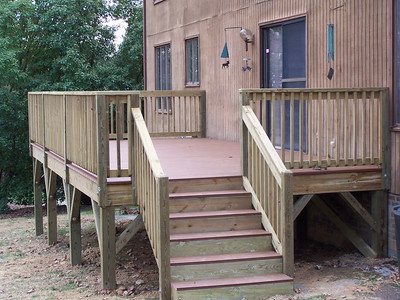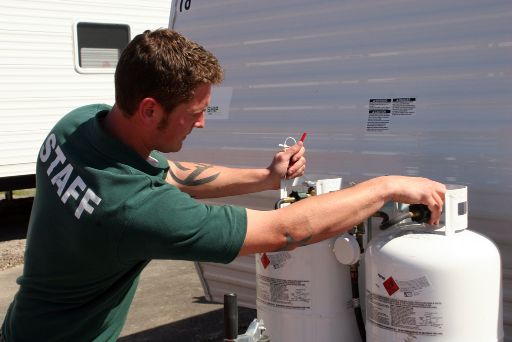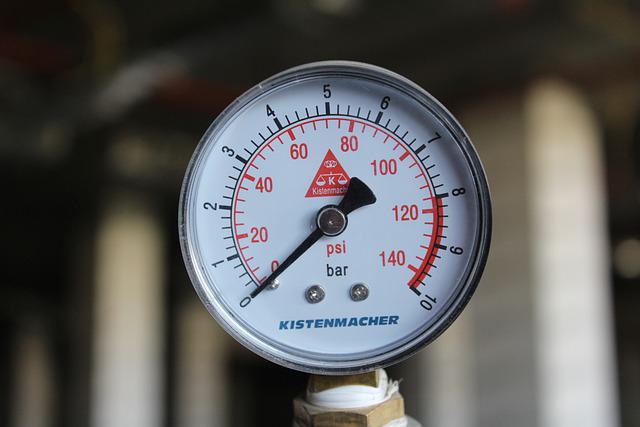
Storing a propane tank under a deck is generally not recommended for several reasons:
- Ventilation: Propane tanks should be stored in a well-ventilated area to prevent the accumulation of gas fumes, which can be dangerous. An enclosed space like under a deck might not provide sufficient ventilation.
- Access to Sunlight and Heat Sources: Propane tanks should not be exposed to excessive heat or direct sunlight, which could cause the pressure inside the tank to increase, posing a risk of explosion. Under a deck, there could be a risk of heat build-up, especially if the deck is exposed to direct sunlight for parts of the day.
- Ease of Access: In case of an emergency, it’s important to have easy access to the propane tank to shut it off. Storing it under a deck might hinder quick access.
- Local Regulations and Safety Guidelines: Many localities have specific regulations regarding the storage of propane tanks, including restrictions on storing them indoors or in enclosed spaces like under a deck. It’s important to check and comply with these regulations.
For safe storage, it’s generally advised to keep propane tanks outdoors, in a well-ventilated area, away from direct sunlight, excessive heat, and ignition sources, and in a location where they can be easily accessed in case of an emergency. Always follow the manufacturer’s guidelines and local regulations for propane tank storage.
Read related article: How Far Can You Smoke from a Propane Tank? (Can You Vape?)
Storing Propane Tanks Under The Deck Is Necessarily Not Recommended
There are a few reasons why it’s not recommended to store a propane tank under a deck. First, propane is a highly flammable gas, so it’s important to keep the tank in a well-ventilated area. Second, if the tank leaks, the gas can collect under the deck and potentially explode. Finally, the weight of the tank can damage the deck over time.
The NFPA 101, The Life Safety Code has a strict prohibition against the installation of propane tanks under decks or areas of egress from a building or structure. This is because propane is a highly flammable gas, and if there were to be a leak or spillage from a tank installed under a deck or area of egress, it could quickly lead to a fire that would put occupants of the building or structure at risk.
In addition to the obvious fire hazard posed by propane tanks, they can also be a source of explosive gas buildup if not properly vented. For these reasons, it is essential that any propane tanks that are used in or around buildings and structures be installed in accordance with the NFPA 101, The Life Safety Code.
Read related article: Do You Need a Permit for a Propane Tank? (2 Documents You Need)
NFPA 101 – Life Safety Code
The National Fire Protection Association’s (NFPA) 101 Life Safety Code is the most widely used source for fire and life safety guidelines in the world. The code is constantly being updated to reflect the latest advances in fire and life safety, and the most recent edition includes a prohibition on the installation of propane tanks under decks or areas of egress from a building or structure.
This prohibition is based on the fact that propane is a highly flammable gas, and if a tank were to leak or be involved in a fire, it could pose a significant hazard to people trying to evacuate the area. In addition, propane tanks are often heavy and difficult to move, so if they are located under a deck or other area of egress, they could block people from being able to safely evacuate.
The NFPA Life Safety Code is developed through an open consensus process that includes input from a wide range of stakeholders, including firefighters, building officials, code enforcement officers, insurance professionals, and others. The code is updated every three years, so it is important to make sure you are using the most current edition. If you have any questions about the NFPA Life Safety Code or how it might apply to your situation, you can contact the NFPA at www.nfpa.org/lifesafety.
ASME and DOT Specifications
When considering where to place ASME and DOT propane tanks, there are specific safety guidelines to follow:
- Distance from Ignition Sources:
- Both ASME and DOT tanks filled on-site must be at least 10 feet away from any external or direct ignition sources. This includes air conditioners, generators, and vents from heating systems or fireplaces. Measure this distance horizontally from the closest liquid withdrawal or fill valve to the ignition source.
- If the tank is not filled on-site (like smaller tanks that are disconnected and filled elsewhere), it can be 5 feet away from the ignition source.
- Proximity to Doors and Windows:
- DOT tanks need to be at least 3 feet away from any door or window that is below the level of the liquid relief or fill valve. This is because propane is heavier than air and can seep into buildings during filling or if there’s a leak.
- For ASME tanks, this minimum distance increases to 5 feet.
- Placement Considerations:
- Avoid placing tanks directly under power lines.
- Tanks should be set on concrete pads or blocks for stability and to allow airflow, which prevents rust.
- Do not place tanks on any type of wood surface, as wood can rot or break, risking the tank falling over.
- Enclosed Spaces and Heat:
- Never place tanks in enclosed spaces like sheds, which can overheat and lack ventilation. This can lead to propane gas getting trapped, causing explosion and fire hazards.
- Keep tanks at least 10 feet away from stored or accumulated combustible materials.
- Under-Deck Installations:
- ASME 120 and DOT 420 tanks (less than 125 gallons) can be installed under a deck if there’s a minimum of 50% open perimeter.
- Be cautious with adding structures like lattice, as this might affect requirements.
- Always follow NFPA 58 codes and local codes before installation.
These rules are designed to ensure safety by reducing the risk of fire, explosion, and propane gas leaks. It’s crucial to adhere to these guidelines and consult local regulations for specific requirements in your area.
How Close to the Deck Can Propane Tank Be?
The answer to this question depends on the type of propane tank you have. If you have a standard 20-lb propane tank, it can be as close as 3 feet to the edge of your deck. However, if you have a larger tank, such as a 100-lb tank, it must be at least 10 feet from the edge of your deck. For an even larger tank (500-gallon), it must be placed a minimum of 25 feet from the nearest structure.
Here are some key technical aspects to consider:
- Distance from Ignition Sources: Propane tanks should be placed at least 10 feet (3 meters) away from ignition sources. This includes parts of the home like decks, which may have electrical equipment, grills, or other sources of flame or heat.
- Clearance from Building Openings: Tanks should be positioned at least 5 feet (1.5 meters) from any building opening, such as windows, vents, or doors. This is to prevent propane vapors, in case of a leak, from entering the building.
- Vertical and Horizontal Clearance: For vertical clearance, a propane tank should typically not be placed directly under an overhead structure like a deck. Horizontally, maintaining a distance of at least 10 feet from the edge of the deck is advisable.
- Access and Ventilation: Ensure that the tank is easily accessible for refilling, inspection, and emergency shut-off. It should also be in a well-ventilated area to prevent the accumulation of propane fumes.
- Capacity of the Propane Tank: The required distances may vary based on the size of the propane tank. Larger tanks often require greater distances from buildings and property lines. For instance, tanks over 125 gallons (500 liters) capacity might need to be further away compared to smaller tanks used for grilling.
- Local Building Codes and Regulations: Always check your local building codes and regulations. Different municipalities may have specific requirements for propane tank placement relative to structures like decks.
Additionally, place the propane tank on a stable surface and ensure it’s in an open area for good air flow. This helps in case there’s a gas leak – the gas won’t build up and cause a dangerous situation. Remember, it’s important for the tank to be easily reachable in case you need to turn it off quickly in an emergency. Following these simple guidelines will help keep your home and family safe when using and storing a propane tank near your deck.
Where Should You Put Propane Tank in Your Yard?
There are a few things to consider when deciding where to place your propane tank in your yard.
You’ll want to make sure the tank is in a safe, accessible location. You’ll want to consider the size and weight of the tank when deciding on its placement. And you’ll want to choose a spot that’s close to your home or other buildings on your property.
When it comes to safety, you’ll want to make sure the tank is placed away from any potential hazards like trees, bushes, and other objects that could damage the tank. You’ll also want to ensure the tank is easily accessible in case you need to refill it or make any repairs.
The size and weight of the tank are important factors to consider when choosing its placement. A larger tank will be more difficult to move, so you’ll want to make sure it’s in a spot that’s not too hard to access. And if you have a heavy tank, you’ll want to avoid placing it on uneven ground where it could tip over.
Also, when choosing a spot for your propane tank, don’t hide it behind bushes or in a corner where you can’t see it well. It’s important to have a clear view of it for regular checks and to make sure it’s in good condition. Avoid putting it in low areas where water can collect, as standing water can cause rust and damage the tank. Keep it in an open space to ensure good airflow around it, which is important for safety, especially if there’s a leak. Remember, the place you choose should be safe, easy to access, and follow your local safety rules. This way, you keep your home and family safe while using the propane tank.
Safety Concerns
Storing a propane tank under a deck isn’t safe mainly because this area usually doesn’t have enough open air. If the tank has a small leak, which can sometimes happen, the gas from the tank could start to build up under the deck. Propane gas is heavier than air, so it doesn’t rise and disperse easily; instead, it would gather under the deck. This creates a hidden danger because you might not smell the gas until there’s a lot of it, and by then, it could be really dangerous.
The other problem with under-deck storage is that these areas often don’t have good airflow. Proper ventilation is super important for safety with propane tanks. Without it, any leaked gas just stays in one place, increasing the chances of a fire or explosion if there’s a spark or flame nearby.
Also, decks can trap heat, especially if they are in the sun or made of materials that get hot. Propane tanks need to stay cool because heat can cause the pressure inside the tank to go up. If it gets too hot, the tank’s safety valve might release some gas to lower the pressure, but this is risky if it’s under your deck. Or, in a worst-case scenario, the tank could even burst if the pressure gets too high and there’s no safety valve action.
So, it’s always better to find a place for your propane tank where it can be out in the open, with lots of fresh air around it and away from places that get hot. This helps to keep you, your family, and your home safe.
Importance of Following Safety Guidelines
Following safety guidelines for propane tank storage is crucial for several reasons:
- Preventing Accidents and Fires: Manufacturer guidelines are designed to minimize the risk of accidents and fires. These guidelines consider the properties of propane, including its flammability and the way it can accumulate in enclosed spaces. By adhering to these recommendations, you greatly reduce the risk of dangerous incidents.
- Compliance with Local Regulations: Local regulations regarding propane storage are put in place to ensure public safety. These might include specific rules about the distance of the tank from structures, how to secure it, and the proper placement to prevent accidents. Not following these regulations can lead to legal consequences, including fines.
- Consequences of Improper Storage:
- Health and Safety Risks: Improper storage can lead to gas leaks, which are a serious health hazard and can cause explosions or fires.
- Property Damage: A leak or fire from a poorly stored propane tank can cause significant damage to your home and property.
- Liability Issues: If a propane tank that is not stored correctly causes damage or injury, you may be held liable for these damages.
- Insurance Complications: Failing to follow safety guidelines might violate the terms of your home insurance policy, potentially leading to issues with claims if an accident occurs.
Following manufacturer guidelines and local regulations for propane tank storage is essential for maintaining safety, preventing accidents, and avoiding legal and financial repercussions. These guidelines are not just recommendations; they are critical measures for protecting you, your family, your property, and your community.
To Make a Conclusion
While it’s technically possible to store certain smaller propane tanks (ASME 120 and DOT 420, less than 125 gallons) under a deck, this should be done with caution and adherence to strict safety guidelines. The area under the deck must have at least a 50% open perimeter to ensure adequate ventilation and to reduce risks. However, larger tanks, or those being filled on-site, require more careful placement, typically at least 10 feet away from ignition sources and structures. It’s crucial to always follow NFPA 58 codes, local safety codes, and manufacturer guidelines. When it comes to propane tank storage, prioritizing safety and adhering to established regulations is essential to prevent potential hazards like fires or gas leaks.
Moreover, it’s important to remember that while some exceptions exist for smaller tanks, the general rule of thumb for safety is to avoid enclosed or partially enclosed spaces like under decks. This precaution is due to the inherent risks associated with propane, a highly flammable gas.
The need for proper ventilation and the danger of gas accumulation in case of a leak make open, well-ventilated areas far more suitable for propane storage. Additionally, always consider the tank’s proximity to potential ignition sources, doors, windows, and high-traffic areas.
Ensuring stability on a non-combustible base and keeping the tank away from combustible materials are also key safety measures. In essence, while storage under a deck might be feasible under specific conditions and for smaller tanks, it’s generally advisable to opt for a safer, more open location to ensure the utmost safety of your property and loved ones.

Mike is an experienced propane technician with over 15 years of professional experience in the field. He has dedicated his career to helping customers with their propane needs, from installation to maintenance and repair. Together with Jeremy, he co-founded this website to provide useful information and guidance to customers seeking reliable propane services.




